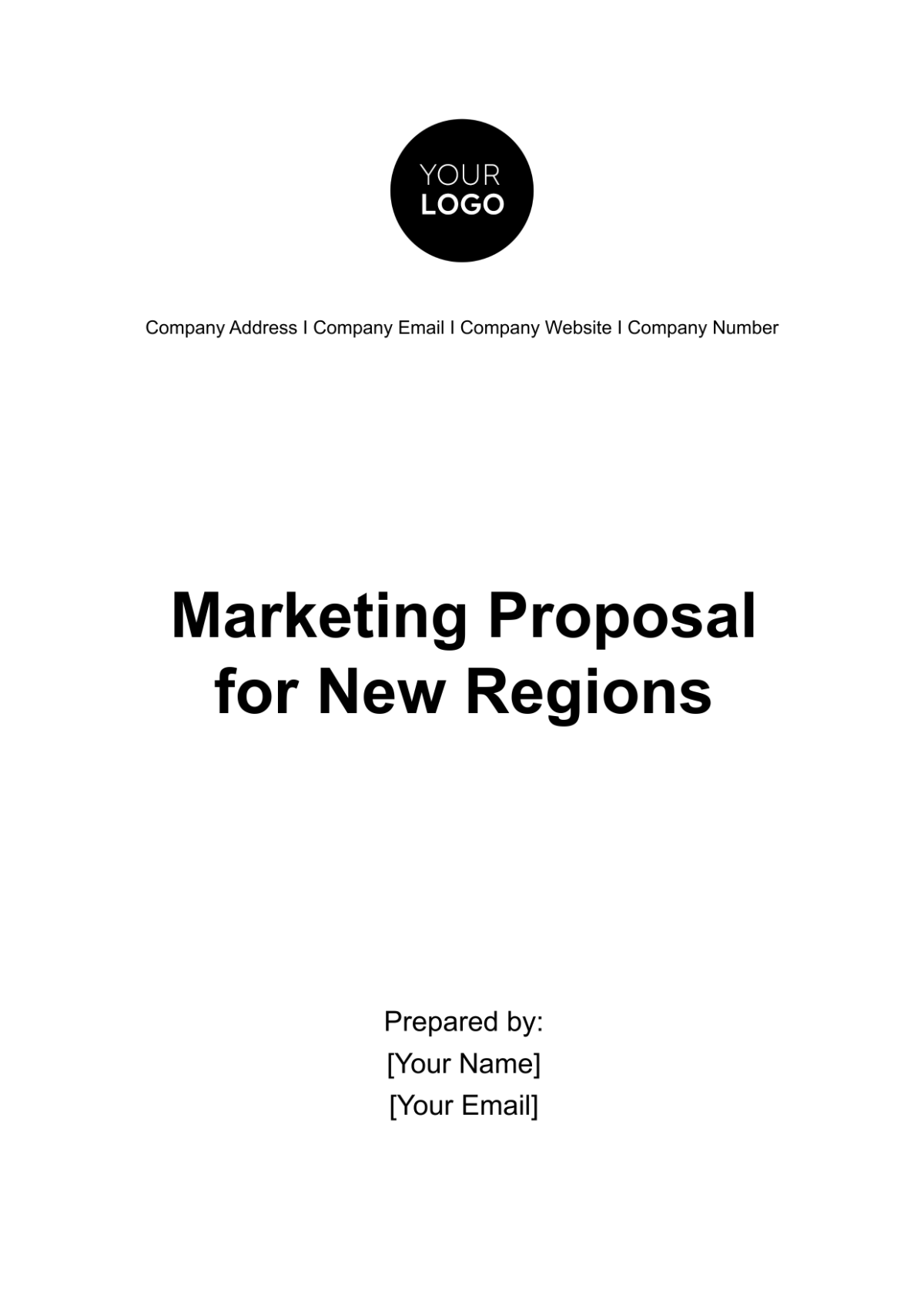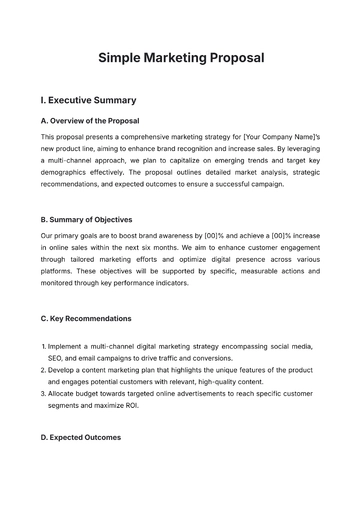Free Marketing Proposal for New Regions

I. Executive Summary
[Your Company Name] is a leading provider of IT solutions, specializing in cybersecurity and cloud computing. With a successful track record in North America and Europe, we aim to expand into the Asia-Pacific region, specifically targeting Singapore and Malaysia. Our goal is to capture a significant market share within the next 18 months.
II. Introduction
[Your Company Name] has established itself as a trusted leader in the cybersecurity and cloud computing industry. Our expansion into the Asia-Pacific region aligns with our strategic objectives to diversify our customer base and tap into emerging markets with growing IT demands.
III. Market Research and Analysis
A. Market Overview
Singapore Market Overview
Singapore boasts a robust and digitally mature economy with a GDP of $380 billion. The country's strategic location, strong infrastructure, and pro-business policies make it a prime destination for IT investments. The government's push towards becoming a Smart Nation further accelerates the demand for advanced cybersecurity and cloud solutions.
Malaysia Market Overview
Malaysia is experiencing a rapid digital transformation, driven by a growing middle class and government initiatives like Industry 4.0. With a GDP of $354 billion, it offers a vibrant business landscape. The market is characterized by a mix of SMEs and large enterprises looking to bolster their cybersecurity and cloud capabilities.
Regional IT Landscape
In both markets, the IT sector is marked by a growing awareness of cybersecurity threats and a pressing need to migrate to cloud-based solutions. This creates a significant opportunity for us to position our services as essential components of their digital transformation journeys.
B. Target Audience
Singaporean Audience:
In Singapore, our primary focus will be on mid-sized enterprises (100-500 employees) across industries such as finance, healthcare, and logistics. We will target IT managers and CTOs who prioritize data security, compliance, and scalability.
Malaysian Audience:
In Malaysia, we will cater to both mid-sized enterprises and larger corporations. Our target audience will include IT decision-makers in manufacturing, e-commerce, and government sectors. These businesses are seeking solutions that align with Industry 4.0 standards and enhance their competitive edge.
Customer Pain Points:
Through in-depth surveys and interviews, we have identified common pain points among our target audience, including concerns about data breaches, compliance with regional data protection laws, and the need for cost-effective, scalable cloud solutions.
C. Competitor Analysis
CyberShield Asia:
This local competitor has a strong presence in the Asia-Pacific region, particularly in Singapore. They are known for their data-centric cybersecurity solutions and have established partnerships with several local enterprises. However, they lack the global reach and comprehensive cloud services that we offer.
TechVanguard Solutions:
TechVanguard Solutions is a regional player with a focus on cloud computing. While they have a presence in both Singapore and Malaysia, their cybersecurity offerings are limited. We have an opportunity to differentiate ourselves by providing an integrated cybersecurity and cloud solution.
Local Market Players:
In addition to these competitors, there are numerous smaller local players in both markets. They often lack the breadth of services and global experience that we can bring to the table. However, they may have established relationships that we need to be mindful of.
D. SWOT Analysis
Strengths:
Global Brand Reputation: Our track record and global presence provide credibility and trustworthiness.
Diverse Product Portfolio: Our comprehensive offerings encompass both cybersecurity and cloud solutions.
Extensive Global Network: Existing international partnerships can be leveraged for market entry.
Weaknesses:
Lack of Local Market Knowledge: We must bridge the gap in understanding local customs, regulations, and market nuances.
Potential Regulatory Hurdles: Compliance with regional data protection and cybersecurity regulations may present challenges.
Initial Limited Market Awareness: Our brand may not be well-known in the new regions initially.
Opportunities:
Growing Demand for Cybersecurity: The increasing frequency of cyber threats in the Asia-Pacific region creates a substantial demand for our services.
Booming IT Sector: The region's rapid digitalization means an expanding market for our cloud solutions.
Strategic Partnerships: Collaborating with local partners can provide valuable market insights and access to a ready customer base.
Threats:
Intense Competition: Local and regional competitors may respond aggressively to our entry.
Regulatory Changes: Evolving data protection and cybersecurity regulations could impact our operations.
Economic Uncertainties: Economic fluctuations or crises in the region could affect IT spending by potential clients.
IV. Marketing Strategy
Our marketing strategy for expanding into the Asia-Pacific region, specifically targeting Singapore and Malaysia, is based on a comprehensive approach that takes into account the unique characteristics of these markets and leverages our strengths as a global IT solutions provider.
A. Market Entry Strategy
Market Entry Partnerships:
We will collaborate with established local IT firms in Singapore and Malaysia to facilitate our market entry. These partnerships will provide us with valuable insights into the local business environment, regulatory requirements, and customer preferences. By leveraging their existing networks, we can accelerate our market penetration.
Joint Ventures:
Exploring joint ventures with local IT companies is also on the table. This approach allows us to combine our global expertise with the local knowledge and resources of our partners, creating a mutually beneficial alliance that fosters rapid growth and credibility in the region.
B. Product/Service Positioning
Customized Solutions:
Our product portfolio, including cybersecurity solutions and cloud services, will be tailored to meet the specific needs and preferences of businesses in Singapore and Malaysia. We will invest in research and development to ensure that our offerings align with local regulations and address regional cybersecurity concerns.
Localized Marketing:
To position our products effectively, we will incorporate local culture, language, and imagery into our marketing materials. This will resonate with the target audience and create a sense of trust and familiarity.
C. Pricing Strategy
Competitive Pricing:
To gain a competitive edge, we will adopt a pricing strategy that offers cost-effective solutions without compromising on quality. By analyzing local pricing trends and competitor offerings, we will set prices that attract mid-sized enterprises while maintaining healthy profit margins.
Bundling and Discounts:
To incentivize adoption, we will introduce bundled packages that combine cybersecurity and cloud services at a reduced rate. Early adopters and long-term contracts will also be rewarded with special discounts.
D. Distribution Strategy
Local Partnerships:
Our distribution strategy relies on local partnerships. We will collaborate with well-established IT distributors and resellers who have an existing client base in the target regions. These partners will handle the distribution, installation, and ongoing support of our products and services.
Regional Office:
To provide on-the-ground support, we will establish a regional office in Singapore that will serve as a hub for our operations in the Asia-Pacific region. This office will house sales, customer support, and technical teams dedicated to the local market.
E. Promotion Strategy
Digital Marketing:
A significant portion of our promotional efforts will focus on digital marketing. We will utilize search engine marketing (SEM), social media advertising, and content marketing to raise awareness of our brand and products among our target audience.
Participation in IT Expos:
To engage directly with potential customers and showcase our solutions, we will participate in key IT expos and trade shows in Singapore and Malaysia. These events will allow us to demonstrate our products, connect with decision-makers, and gather valuable leads.
Local PR and Media Coverage:
Building trust and credibility is essential in these markets. We will collaborate with local PR agencies to secure media coverage and press releases, highlighting our commitment to the region and the benefits of our solutions.
By implementing this comprehensive marketing strategy, we aim to not only enter but thrive in the Singapore and Malaysia markets. This approach considers the unique dynamics of the Asia-Pacific region while leveraging our global expertise to meet the evolving needs of our target audience. Our strategy is flexible, allowing us to adapt to changing market conditions and customer feedback as we work towards achieving our expansion goals.
V. Budget and Resource Allocation
We have allocated $2 million for the expansion project, with the majority allocated to marketing and partner development activities.
VI. Implementation Plan
A. Timeline
Phase | Timeline |
Market research and partner selection | November 2050 |
Product localization and regulatory compliance | January 2051 |
Launch in Singapore | March 2051 |
Launch in Malaysia | May 2051 |
B. Key Milestones
Partner agreements signed
Regulatory approval obtained
Successful product localization
Launch events executed
VII. Measurement and Analytics
A. Key Performance Indicators (KPIs)
Key Performance Indicator | Measurement Method | Target |
Market Share | Sales data analysis | 15% market share in Singapore and Malaysia within 18 months |
Customer Acquisition Rate | Number of new clients | 500 new clients in the first year |
Revenue Growth | Financial reports | 30% YoY revenue growth |
Brand Recognition | Surveys and online mentions | 80% brand recognition in the target audience |
B. Reporting Frequency
Monthly reports will be reviewed by the executive team to track progress and make necessary adjustments.
VIII. Risk Assessment
Potential risks include regulatory challenges, market competition, and cultural differences. Mitigation strategies are in place to address each risk.
IX. Conclusion
Expanding into the dynamic markets of Singapore and Malaysia represents a significant strategic move for [Your Company]. Our comprehensive marketing proposal, grounded in thorough market research and a well-defined strategy, positions us for success in these promising regions.
Thank you for your trust and support as we embark on this exciting journey. Together, we will make a significant impact in these thriving markets, solidifying [Your Company] as a global leader in cybersecurity and cloud computing solutions.
- 100% Customizable, free editor
- Access 1 Million+ Templates, photo’s & graphics
- Download or share as a template
- Click and replace photos, graphics, text, backgrounds
- Resize, crop, AI write & more
- Access advanced editor
Expand your market reach with our Marketing Proposal for New Regions Template, exclusively on Template.net. This editable resource offers a comprehensive framework for proposing strategic expansion plans. Utilize our AI Editor Tool for seamless customization tailored to your target regions. Elevate your proposals and capture new market opportunities with confidence.
You may also like
- Business Proposal
- Research Proposal
- Proposal Request
- Project Proposal
- Grant Proposal
- Photography Proposal
- Job Proposal
- Budget Proposal
- Marketing Proposal
- Branding Proposal
- Advertising Proposal
- Sales Proposal
- Startup Proposal
- Event Proposal
- Creative Proposal
- Restaurant Proposal
- Blank Proposal
- One Page Proposal
- Proposal Report
- IT Proposal
- Non Profit Proposal
- Training Proposal
- Construction Proposal
- School Proposal
- Cleaning Proposal
- Contract Proposal
- HR Proposal
- Travel Agency Proposal
- Small Business Proposal
- Investment Proposal
- Bid Proposal
- Retail Business Proposal
- Sponsorship Proposal
- Academic Proposal
- Partnership Proposal
- Work Proposal
- Agency Proposal
- University Proposal
- Accounting Proposal
- Real Estate Proposal
- Hotel Proposal
- Product Proposal
- Advertising Agency Proposal
- Development Proposal
- Loan Proposal
- Website Proposal
- Nursing Home Proposal
- Financial Proposal
- Salon Proposal
- Freelancer Proposal
- Funding Proposal
- Work from Home Proposal
- Company Proposal
- Consulting Proposal
- Educational Proposal
- Construction Bid Proposal
- Interior Design Proposal
- New Product Proposal
- Sports Proposal
- Corporate Proposal
- Food Proposal
- Property Proposal
- Maintenance Proposal
- Purchase Proposal
- Rental Proposal
- Recruitment Proposal
- Social Media Proposal
- Travel Proposal
- Trip Proposal
- Software Proposal
- Conference Proposal
- Graphic Design Proposal
- Law Firm Proposal
- Medical Proposal
- Music Proposal
- Pricing Proposal
- SEO Proposal
- Strategy Proposal
- Technical Proposal
- Coaching Proposal
- Ecommerce Proposal
- Fundraising Proposal
- Landscaping Proposal
- Charity Proposal
- Contractor Proposal
- Exhibition Proposal
- Art Proposal
- Mobile Proposal
- Equipment Proposal
- Student Proposal
- Engineering Proposal
- Business Proposal





























